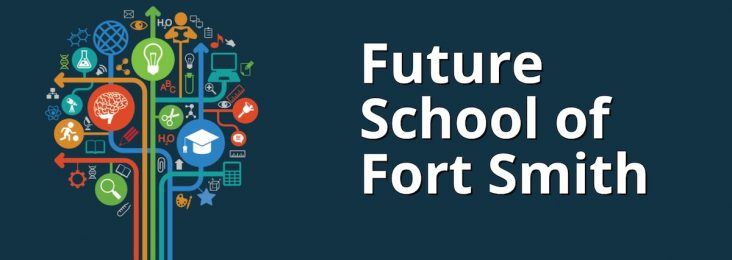Future School building a ‘different mindset’ model for students, teachers
by February 4, 2016 11:22 am 511 views

The Future is now the Present for Trish Flanagan and her efforts to launch the Fort Smith area’s first public charter school for grades 10-12.
The last few months have seen Future School of Fort Smith ticking off a number of items on its to-do list. In November 2015, it won approval from the Arkansas Board of Education to open for the 2016-2017 school year – Aug. 22, 2016, to be exact.
Then, the Fort Smith Board of Directors voted Jan. 19 to sell city-owned property at 622 N. 7th St., as well as 515 and 701 N. 8th Streets, to Northwest Development Holdings (NDH).
The purpose: to secure Future School a location.
Now the charter’s staff can focus on educating. To do that, however, it will need teachers and students, and the search is on.
“We’ve set ambitious goals for ourselves,” Flanagan told Talk Business & Politics. “By April 1, we plan to have the first 150 students enrolled. We already have 20 through word-of-mouth, and we’ve got a number of events in the coming weeks to help with outreach.”
If those events are “too” successful – for example, Future School receives more registrants than its 150 goal – a “lottery” will be held to make the final selections.
In year one, Future School will be accepting 150 10th grade students, followed by 150 more in 2017 and another 150 the year after. The first graduating class will receive their diplomas in 2019. At full capacity, and for the foreseeable future, the charter school will have a capacity of 450 students.
THE STUDENTS
Prior to Future School of Fort Smith, Flanagan co-founded Noble Impact, a K-12 education initiative integrating public service with an entrepreneurial mindset. Future School will share similar goals, integrating “real world” experience with classroom training and empowering students to customize their educational plan based on their individual interests while meeting state and federal standards.
For a more concrete example of what that means, Flanagan shared a recent scenario in an op-ed for TB&P: “Consider Monica, a student interested in botany who develops an internship at a local landscape company contracted to create outdoor space at the new U.S. Marshal’s Museum,” Flanagan writes. “With support from her learning team, Monica presents her project proposal to her mentor at the company. She plans to identify every insect that might have an adverse or beneficial effect on the landscape they create. The work in her project-based biology class on Wednesday is helping Monica understand plant cellular structure. Yet, to change things up and allow for authentic assessment, Monica and her biology instructor plan to incorporate her internship work in class by creating a standards-based project that explains the biological environment she and her mentor are designing for the museum.”
Students like “Monica” will be furnished a laptop computer by the school, and they will be required each week to attend the 7th/8th Street location to work with their advisor on plan implementation and development.
“We know how important having physical space is for students,” Flanagan said. “This is a true blended model of online, on-campus, and real world learning. Students can’t just leave campus when they want. They have to get approved by their advisor and mentor. It’s a very professional process they have to follow.”
Flanagan also said Future School will be a place for students of all educational stripes and “not just students that it comes easy to.” She continued: “Some students may go to UAFS to take concurrent credit classes. Some to culinary classes if that’s their thing. Every student has their own learning plan.”
THE TEACHERS
The search for teachers is “an open ballgame,” Flanagan said, adding that the school will be “open to instructors with non-traditional backgrounds.”
“We want a diverse team with experience in different sectors and teaching. Specifically, we have our three C’s. They have to ‘care’ about kids; they have to be experts in their ‘content’ area; and they have to be ‘coachable,’ because what we’re doing is a different mindset. It’s certainly different from how most of us grew up learning.”
Future School’s website breaks it down further, giving an overview of the hiring process as a whole. A teacher interested in the opportunity would send a resume and cover letter, after which they will “receive an acknowledgement email within a week.” Applicants who are moved forward would then participate in either a phone or face-to-face interview. From there, “a second interview will take place that may involve a number of activities, from a student tour to teaching a class to a panel interview,” the site notes.
Lastly, a background check “and other verification steps” would be conducted before a final offer.
UPCOMING EVENTS
To help reach the enrollment goal, Future School will be participating in a number of outreach events between now and the April 1 deadline.
The two nearest will include a “Diversity Dinner,” which is being organized by juniors and seniors from Northside and Southside High Schools and is slated for Feb. 20 at the Stephens Boys & Girls Club at 3101 N. 6th St. The event will include free food, dancing, and live entertainment.
The second event will be a trivia night on March 10 in association with Girls Inc., and will be hosted by Core Brewing Co. at 701 Rogers Ave.
Flanagan said the outreach team is in the process of organizing a Mural Painting event in association with the Unexpected Project, the group behind 2015’s popular downtown building murals. Details are forthcoming.
